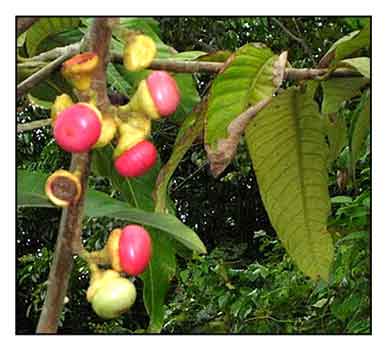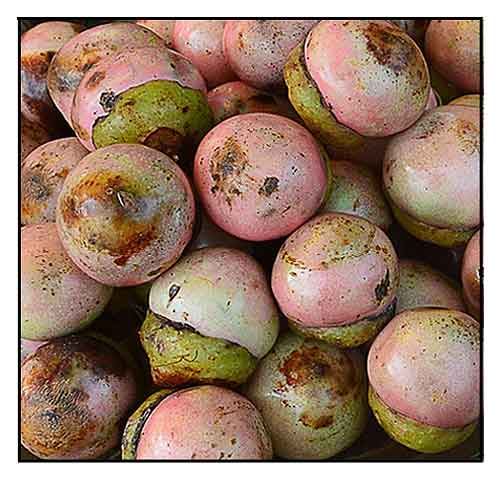 Gen info Gen info
- Lauraceae comprises about 50 genera and 2500-3500 species. Litsea is the second largest genus under Lauraceae.
-
Litsea garciae is one of the 50 genus in the Lauraceae family. L
-
Etymology: The genus Litsea derives from Chinese 'Li', meaning plum, and 'tse', meaning small.
- Generally believed to have originated in the Philippines, but some botanists believe it originated from Borneo. (3)
Botany
- Litsea garciae is a medium-sized tree tree up to 26 m tall. Trunk measures 40-50 cm in diameter. Leaves are simple, arranged alternately. Leaf blades are ovate to lanceolate, measuring about 12-50 cm long and 15-18 cm wide. Young leaves are silvery shiny. Flowers are very small, measuring about 15 mm in diameter, yellowish-white in color. Fruits are oblate, 2.5-4.5 cm in diameter, with pink skin and creamy white flesh. Fruits are seated on cup-shaped cohering bracts. (4)
Litsea garciae is a sub-canopy, medium to large evergreen tree up to 10–26 meters (32–85 feet) in height. The trunk can reach 60 centimeters (23 inches) in diameter. The dark green leaves are simple and alternately arranged and are lanceolate-ovate or lanceolate-obovate in shape. They are glabrous and measure 25-40 centimeters (10-16 inches) in length and 6-15 centimeters (2-6 inches) in width. They droop slightly from the branches. The flowers are small and yellow-white in color. The flower head measures 15 millimeters in diameter. The fruit is oblate to globose in shape and measures 2.2-3 centimeters (0.8-1 inches) in height and 2.5-4.5 centimeters (1-2 inches) in diameter. It is edible and has a milky, avocado-like flavor. When unripe, the skin is a pale whitish-green, and when ripe is pink to red in color. The inner flesh is soft and white in color, sometimes with a greenish tint. The stem cap is large and green in color. It contains 1 large, brown seed which measures 1.5-2 centimeters (0.6-0.8 inches) in diameter. (3)
 Distribution Distribution
- Native to the Philippines.
- Also native to Taiwan, Brunei, Malaysia, Indoneisa, specially to Peninsular Malaysia and the islands of Borneo, Sumatra, Java, and Sulawesi.
(3)
- Grows primarily in wet tropical biome(s).
- In mixed forests up to 200 m altitude. Found along rivers and streams, and hillsides with sandy clay soils.
Constituents
- In a study of leaf and bark extracts, ethanol extract showed highest total phenol content with value of 0.9-1.0 µg/mg GAE. Highest total flavonoid content was 10.1 µg/mg CE. (see study below) (5)
- Study of bark yielded major phenolic compounds including N-trans-feruloyl-4-O-methyldopamine, N-cis-feruloyltyramine, epicatechin-(4beta->6)-epicatechin-(2beta->7,4beta->8)-epicatechin, 7-hydroxy-3-(4-methoxyphenyl)-4-propyl-2H-1-benzopyran-2-one and 9-O-methylneodunol. (see study below)
(6)
- Study of leaves for alkaloidal contents isolated five known bases: laurolitsine (1), actinodaphnine (2), (+)-reticuline (3), isodomesticine (4), and boldine.
(8)
Properties
Studies have suggested antioxidant, antibacterial properties.
Parts used
Bark, leaves, seeds.
 Uses Uses
Edibility
- Fruit is edible; eaten raw or cooked. Eaten raw, it is rolled in the hands or hit and bruised with a spoon to release the flavor. Eaten after boiling or being submerged in hot water, it is sprinkled with salt. Pulp has an avocado-like flavor.
- Unripe fruits are pickled.
Folkloric
- Poultice of bark used to treat boils.
- The Iban use lightly burned bark to treat caterpillar stings. Selako use poultice of leaves of shoots along with shallot and fennel to treat infections and skin diseases. The Penan use poultice of bark for sprained knees and ankles and muscular pains. Bark decoction used for blood in the stools. Bark decoction mixed with durian bark used as antidote for snakebite wounds.
(3)
Others
- Oil: Seed oil used in making candles and soap.
- Wood: Used in construction.
Studies
• Antioxidant / Antibacterial: Study evaluated the antioxidant and antibacterial activities of extracts of L. garciae leaf, bark, and branch. Highest antioxidant activity was found in the ethyl acetate extract (86%) at 100 ppm concentration, with IC50 of 41.54 ppm. The ethanol extract showed potential to inhibit growth of P. acnes bacteria. (see constituents above) (5)
• Antioxidant / Bark: Study evaluated the antioxidant property of L. garciae hexane, chloroform, methanol, and aqueous extracts of bark in measures of total flavonoid content, total phenolic content, DPPH and FRAP assays. The methanol extract showed highest TPC value and antioxidant capacity with least IC50. The significant free radical scavenging activity was attributed to the high phenolic content. Results suggest the bark may be a promising source of novel natural compounds with antioxidative properties. (see constituents above)
(6)
• Antioxidant / Phytochemical / Fruit: Study evaluated the antioxidant activity and total phenolic, total flavonoid, and total anthocyanin contents of various freeze-dried fruit parts i.e., flesh, stem cap, and seed. The 80% methanol extract of stem cap displayed highest free radical scavenging activity and ferric reducing activity. TPC and TFC were highest in stem cap with values of 8.29 mg GAE/g and 6.90 mg rutin equivalents/g, respectively. Total anthocyanin content was highest in the flesh with 4.12 mg cyanidin-3-glucoside equivalents/100 g. Results suggest a potential source of natural antioxidants that can contribute to human health. (7)
• Fatty Acid Composition / Antimicrobial / Pulp and Seed: Study evaluated and compared the fatty acid composition and antimicrobial activities of pulp and seed extracts of L. garciae. Fatty acids of seed extracts were more than 80% saturated fatty acids, while pulp extracts yielded approximately 50% saturated and unsaturated fatty acids. Predominant saturated fatty acids in pulp extract were palmitic acid, followed by stearic acid. Seeds showed high content of lauric acid followed by palmitic acid. The predominant monosaturated fatty acid was oleic acid while polyunsaturatd fatty acid was linoleic acid. The lipid pulp extract showed higher antimicrobial activity against S. aureus, P. aeruginosa and S. epidermis. (9)
Availability
Wild-crafted.
Ornamental cultivation. |

![]()






